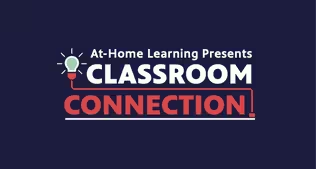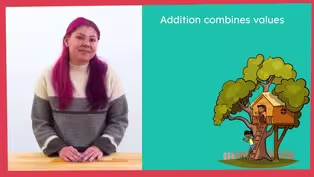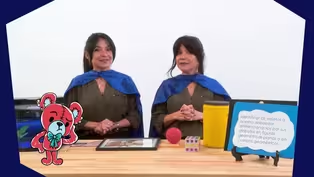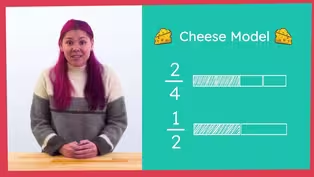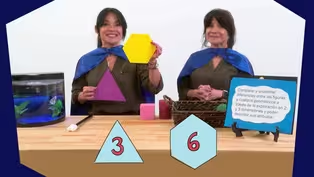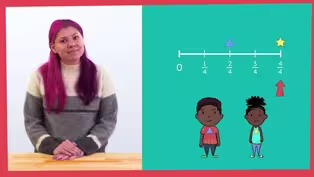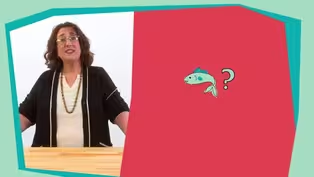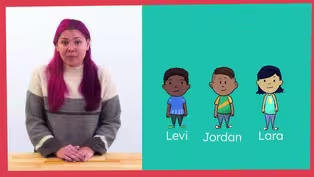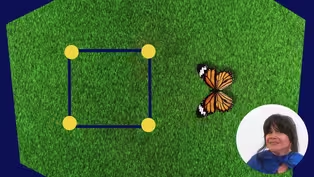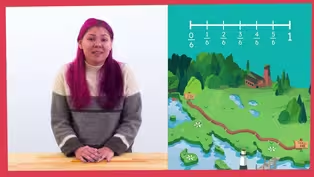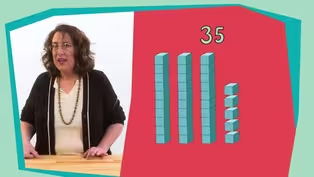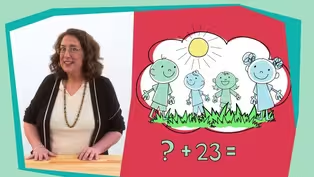
Episode 13 | Math Lessons
3/15/2021 | 28m 46sVideo has Closed Captions
Math lessons for early learners, led by NC teachers.
The first lesson (aimed at PreK-K learners) helps students understand the relationship between numbers and quantities.The second lesson (aimed at 1st-2nd graders) helps learners recognize and combine groups of numbers. Classroom Connection is your At-Home Learning companion where children love to learn. All lessons are led by NC educators.
Problems playing video? | Closed Captioning Feedback
Problems playing video? | Closed Captioning Feedback
At-Home Learning Presents: Classroom Connection is a local public television program presented by PBS NC

Episode 13 | Math Lessons
3/15/2021 | 28m 46sVideo has Closed Captions
The first lesson (aimed at PreK-K learners) helps students understand the relationship between numbers and quantities.The second lesson (aimed at 1st-2nd graders) helps learners recognize and combine groups of numbers. Classroom Connection is your At-Home Learning companion where children love to learn. All lessons are led by NC educators.
Problems playing video? | Closed Captioning Feedback
How to Watch At-Home Learning Presents: Classroom Connection
At-Home Learning Presents: Classroom Connection is available to stream on pbs.org and the free PBS App, available on iPhone, Apple TV, Android TV, Android smartphones, Amazon Fire TV, Amazon Fire Tablet, Roku, Samsung Smart TV, and Vizio.
Providing Support for PBS.org
Learn Moreabout PBS online sponsorshipMore from This Collection
Math lessons for early learners, led by NC teachers.
Video has Closed Captions
Math lessons for early learners, led by NC teachers. (28m 46s)
Video has Closed Captions
Math lessons for early learners, led by NC teachers. (28m 46s)
Video has Closed Captions
Math lessons for early learners, led by NC teachers. (28m 46s)
Video has Closed Captions
Math lessons for early learners, led by NC teachers. (28m 46s)
Video has Closed Captions
Math lessons for early learners, led by NC teachers. (28m 46s)
Video has Closed Captions
Math lessons for early learners, led by NC teachers. (28m 46s)
Video has Closed Captions
Math lessons for early learners, led by NC teachers. (28m 46s)
Video has Closed Captions
Math lessons for early learners, led by NC teachers. (28m 46s)
Video has Closed Captions
Math lessons for early learners, led by NC teachers. (28m 45s)
Video has Closed Captions
Math lessons for early learners, led by NC teachers. (28m 46s)
Video has Closed Captions
Math lessons for early learners, led by NC teachers. (28m 45s)
Video has Closed Captions
Math lessons for early learners, led by NC teachers. (28m 46s)
Providing Support for PBS.org
Learn Moreabout PBS online sponsorship[cheerful upbeat music] ♪ - Thank goodness for today's math lesson.
Math is so important because without it I wouldn't know how many days there are until my birthday.
There are 182 days until my birthday.
How about you?
Let's get into some math to stress those brains.
Here we go.
- Hello, super learners.
Ms. M here.
I'm so glad you are here today.
Are you ready for another math adventure today?
Well, let's get started.
♪ Hello super learners how are you ♪ ♪ Hello super learners how are you ♪ ♪ I'm so glad you're here today ♪ ♪ And I hope you feel the same ♪ ♪ Hello super learners how are you ♪ Oh, super learners, I hope you're feeling great today 'cause I do.
Let's get right into our math power warmups counting to 20.
Are you ready?
Here we go.
♪ One, two, three, four, five, six, seven, eight, nine, 10 ♪ ♪ 11, 12, 13, 14, 15, 16, 17, 18, 19 20 ♪ ♪ That was fun ♪ Now, let's snap count up to 20.
One, two, three, four, five, six, seven, eight, nine, 10.
Let's keep going.
11, 12, 13, 14, 15, 16, 17, 18, 19, 20.
Yes, super learner are the best!
I'm getting so warmed up and I really hope you are too.
One more time counting to 20 but this time we will do it in Spanish.
[counting in Spanish] Great job super learners.
Now it's time to review our colors in English and Spanish.
Red.
[speaking in Spanish] Orange.
[speaking in Spanish] Yellow.
[speaking in Spanish] Green.
[speaking in Spanish] Blue.
[speaking in Spanish] Purple.
[speaking in Spanish] Brown.
[speaking in Spanish] Black.
[speaking in Spanish] White.
[speaking in Spanish] Gray.
Look for these colors in that world today.
Here is our last last math power warm up.
Time for that shape game!
I will see a shape on the screen and then new we'll say its name in English or Spanish.
[speaking in Spanish] Square.
[speaking in Spanish] Circle.
[speaking in Spanish] Triangle.
[speaking in Spanish] Rectangle.
[speaking in Spanish] Rhombus.
[speaking in Spanish] Trapezoid.
[speaking in Spanish] Hexagon.
[speaking in Spanish] Cube.
[speaking in Spanish] Cone.
[speaking in Spanish] Cylinder.
[speaking in Spanish] Sphere.
Shapetastic super learners!
All warmed up?
Then it's time for our math mission of the day!
Let's check with Sparkles the Fish to see what our mission is today.
Thank you Sparkles.
[bright music] Here it is.
Dear super learners, your mission today is to count how many of something there are.
Today, we will count three different groups of objects.
Wow, three groups.
Super learners, I know we can do this mission.
[bright music] Caps on.
math power up!
Let's go!
Hey, here is a basket of apples.
I wonder how many there are.
Let's count them to see how many apples we have.
Ready, set, math power up.
When we count our apples, we can only count each apple once in order to know the right amount.
We will count each apple once until we have counted all the apples.
We know that when we count numbers we count in sequential order.
That means in number order.
Ready?
Let's count these apples.
[bright music] One.
Two.
Three.
Four.
Five.
Six.
Seven.
Eight.
Nine.
And 10.
Way to go super learners!
We counted our first group of objects.
Two more groups to go.
We can do it super learners.
But before we do, let's play a "Math Moose" game.
You will see two cards on the screen.
One will tell us a move and the other will be a number card which will tell us how many to do.
Ready to play?
Math power up!
10 jumps.
One, two, three four, five, six, seven, eight, nine, 10.
Five arm circles.
One, two, three, four, five.
Seven twists.
One, two, three, four, five, six, seven.
Four hops on one leg.
One, two, three, four.
Three spins.
One, whoo!
Two, whoo, don't get dizzy!
Three, whoo!
And eight knee bends.
One, two, three, four, five, six, seven, eight.
Nine arm stretches.
One, two, three, four, five, six, seven, eight, nine.
Whoo!
Well, great job super learners.
I think we are ready for our next group of objects.
I'm gonna clean up the apples first so we have plenty of space to work.
It's important to keep our learning area clean.
[bright music] Come here apple.
Check out these great cups!
I'm going to put them in the line.
[bright music] Just like we did our apples.
Whoo!
You know what?
After that math movement break and looking all these cups, it's making me a little thirsty.
You know what super learners, before we start our activity with these cups, I'm gonna go grab a quick drink of water.
I'll be right back.
Oh, please watch these cups and make sure nothing happens to them while I'm gone.
[jazz music] Oh, so much better.
So much better.
Oh!
Uh-oh!
What happened?
Really?
That was the math burglar!
It looks like they scattered the line of cups.
Well, we've got the super learners.
As we count the cups, we can line them up.
Let's count each of them one by one to see how many they are.
Ready, set, math power up!
Hmm, such a mess but we'll start right here.
One, two, three, four, five, six, seven, eight.
We did it!
We counted the cups and solved the math burglar's puzzle.
Okay, super learners, we have counted two groups of objects.
One more to go.
And I know we are ready for the challenge.
I'm gonna clean up these cups.
And then now look at these spoons.
We know what to do.
Math power up!
Let's count each spoon.
One, two, three, four, five, six, seven, eight, nine, 10.
10 spoons.
We did it super learners!
We counted the objects.
In fact, we counted three different groups of objects.
Let's check back with Sparkles the Fish.
Mission complete.
Congratulations super learners!
You used our math powers and completed the mission.
What do we like to do?
Let's review.
We can count objects by counting each one, one at a time.
Remember to count each object only once in order to get the right total or amount.
Touching each object as we count helps us to count accurately or the correct amount.
Practice counting today super learners.
You can share your math power by showing it to someone.
Thank you super learners for going on a math mission with me today.
Sparkles thanks you too!
Remember, you have to be super at math.
Bye!
Adios!
Math power out.
- Hey there, all this learning is making my brain grow.
Let's check out this next video that will make your heart bigger too.
I love art!
- Hi kids.
Welcome to another episode of "Paint and Sippy Cup".
I'm your host Auntie Jim.
And today I am sipping on cranberry juice.
So, I'm just gonna pour some in my cup.
[upbeat hip-hop music] Today's episode, we're going to be painting one of my favorite animals, a cat and not just any kind of cat, but a purple cat.
You can make your cat whatever color you want.
[upbeat hip-hop music] I'm going to draw the cat first on our canvas.
If you don't have canvas you can just use paper or a cardboard.
[upbeat hip-hop music] So, I'm gonna start with my background first.
[upbeat hip-hop music] Your background can be a different color.
You can use blue.
You can use orange.
You can use green.
You can use yellow.
Whatever color calls out to you.
[upbeat hip-hop music] If you don't have an easel like I do, which is holding my painting up, feel free to paint flat on your table, but make sure you put some newspaper or plastic underneath so that you don't get paint everywhere.
[upbeat hip-hop music] Don't forget to sip your juice.
[upbeat hip-hop music] [hip-hop music] So I'm still waiting on my cat to dry before I add some more layers to it.
So I'm gonna go back into the background now that this is dry so that I can make that pink even brighter.
[hip-hop music] Alright, now that I have my second layer of my cat I can go back and finally fill in my outline.
[hip-hop music] You can add all types of things in the background.
If you want to sun in the background, please add that.
If you want glitter in the background, please add that.
If you want polka dots in the background, words.
Do whatever feels good for you.
Make your art represent who you are.
I want to thank you for joining me on this episode of "Paint and Sippy Cup", where today we painted this cat.
I look forward to seeing what you create.
Keep creating all the time and I'll see you next time.
- Today's affirmation is "My Dreams Are Special".
Now, it's your turn.
My dreams are special.
Say a little louder.
My dreams are special.
One more time.
My dreams are special.
- Hey, did you know an ostrich's eyes is bigger than their brain?
You know what's bigger than your brain?
Your brain after this math lesson.
Let's get into it.
- Hi, friends.
My name is Dawn.
This is Splat and we are so happy to be here with you today to work on fun math.
We are going to have some fun with subitizing.
Remember, that subitizing is quickly seeing how many of an object such as dots.
I am so excited to do this with you today and so is Splat.
We have a tool we are going to use to help us organize the dots we see today.
We are going to use a Ten frame to help us think about numbers that are 10 plus some more.
Sometimes, we might even break apart numbers to make 10.
When we break apart numbers, that is called decomposing.
When we decompose numbers, we can use the smaller numbers to help us make a 10.
Then, we can add on to 10 to find bigger sums or answers.
Your job today is to say how many dots you see with each picture that flashes on the screen.
Then you get to explain or show how you saw the dots to a friend or stuffed animal.
[cat meows] You can tell this to a trusted adult, stuffed animal, or even Splat.
Before we get started, can you go find a stuffed animal or adult to talk to during our subitizing.
You also might want to get some beans or pasta to show the different numbers you see on the screen.
And you might want to get paper and pencil or a notebook to write in, to explain what you learned today.
We'll wait for you to get everything.
[upbeat music] Welcome back!
I hope you found everything that you needed.
This is going to be so much fun.
Oh, I am already!
Are you Splat?
Okay, let's go!
Watch the screen.
That was super quick.
Tell an adult or even a stuffed animal how many dots you saw?
Yes, Splat and I saw 11 also.
How did you see those 11 dots?
Will you whisper to Splat how your brain saw those dots.
Splat said he saw one group of 10 dots and one dot left over and he knows that one plus 10 equals 11.
Did you see that too?
That's really great thinking.
What if I took away the one dot on the side?
How many dots would I have then?
Whisper to yourself how many dots I'd have if I took one away?
Did you say 10?
That's right.
We know that 11 minus one equals 10 and our picture would look like this.
Great job, thinking about the Ten frame.
I think we are ready for another one.
Are you ready?
Watch the screen.
[upbeat music] Wow, Splat!
Did you see that?
It was super fast!
Friends, can you tell Splat how many dots you saw?
13.
That's right.
Great thinking.
Now, can you tell Splat how your brain saw those dots?
[bright music] Friends, I want to share with you how Splat and I saw those group of dots.
I saw four dots on the side and I took one dot and filled up the Ten frame to make it 10.
Then, I had three left over and I know that one 10 and three ones makes 13.
So I broke apart the four dots and used one dot to make a full Ten frame then added the three dots I had left over.
Are you ready to try some more?
Splat is.
Watch the screen for a new image.
[bright music] Whoa, did you see that?
How many dots were there?
Tell an adult or stuffed animal how many dots there were.
Did you say that you saw 14 dots.
Splat agrees.
How did you know there were 14 dots?
Tell Splat how your brain figured that out or make the dots with your beans or pasta.
[bright music] Splat said he tried to break apart or decompose the extra six dots and slid two of them into to the Ten frame.
Then, he had four leftover and he knows that 10 and four makes 14.
Oh, that's right Splat.
You could also see that there are eight dots in the Ten frame and six on the side and know that eight plus six equals 14.
There are so many ways to figure out how to make 14.
I have one more question about this Ten frame and dots.
What would I have if I took away a 10.
Think to yourself how many dots I'd have if we took away one whole ten?
Whisper to a friend or stuffed animal what's your answer is.
[bright music] That's right.
We'd have four left if we took away a 10.
Tell Splat how you got your answer of four.
[bright music] I heard someone say that if we have one 10 and four ones and we take away a 10 we are left with four ones.
That's correct.
14 minus 10 equals four.
Okay, friends, Splat and I have time for one more image.
Are you ready?
Watch the screen.
[bright music] Wow, Splat was so surprised.
Did you see that?
There are two Ten frames.
Tell Splat how many dots you saw?
[bright music] 15!
Yes, great work.
Now tell Splat how you knew there were 15 dots.
Splat said he saw one group of 10 and one group of five and he knows that 10 plus five equals 15.
Did you see that too?
But wait, I have one more question.
How many dots would we need to make 20?
I know that's a big number.
Whisper to yourself how many and how you would know.
[bright music] Splat and I heard you say five.
That's right.
If we added five dots to the bottom row, we'd have two Ten frames full of dots or 20 dots, because we know that 10 plus 10 equals 20.
That is great thinking about numbers and using your doubles facts to help you.
Splat and I have had so much fun here with you today.
We love subitizing with you and decomposing numbers.
When we subitize, we see things such as dots quickly.
When we decompose numbers, we break apart a number into smaller numbers.
We can use the smaller numbers to help us add on to make a new number.
Before we go, Splat and I would love to hear you say what you learned today in your own words.
I have this sentence starters and I'm hoping you can finish these sentences with me.
They say, today in math I learned... And I can...
So I might say, "Today in math I learned how to subitize with numbers in Ten frames."
"I can decompose numbers into smaller numbers and help me add on to find a total."
Now it's your turn.
Read this me and finish it by telling an adult or stuffed animal.
Today in math I learned... Great, now let's read our next sentence and you can finish it.
I can... [bright music] What a great job you are doing talking about your math learning.
Next, you could also write this on paper or in your notebook and start a math journal.
Splat and I must go now.
But you did a lot of hard thinking about numbers and how they combine to make new numbers.
You also did a great job of talking about your learning at the end.
Great work, and we hope we see you soon.
- Wow, time sure does fly when you're learning and having fun.
I want to thank you so much for joining us today on PBS North Carolina.
You are so smart, so special, and so fun to be with.
Wishing you peace, love, and learning my friends.
♪ This is your captain speaking ♪ ♪ You ready for lift off ♪ ♪ At home learning ♪ ♪ Yeah, from the classroom through history ♪ ♪ And now the space ♪ ♪ To dinosaurs and habitats from another place ♪ ♪ To the Big Bang and matter in every state ♪ ♪ Thank goodness for this time right at home ♪ ♪ At home learning ♪ ♪ [cheerful upbeat music] ♪


- Home and How To

Hit the road in a classic car for a tour through Great Britain with two antiques experts.












Support for PBS provided by:
At-Home Learning Presents: Classroom Connection is a local public television program presented by PBS NC
